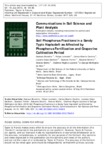Use este identificador para citar ou linkar para este item:
http://www.alice.cnptia.embrapa.br/alice/handle/doc/963515Registro completo de metadados
| Campo DC | Valor | Idioma |
|---|---|---|
| dc.contributor.author | BRUNETTO, G. | pt_BR |
| dc.contributor.author | LORENSINI, F. | pt_BR |
| dc.contributor.author | CERETTA, A. | pt_BR |
| dc.contributor.author | GATIBONI, L. C. | pt_BR |
| dc.contributor.author | TRENTIN, G. | pt_BR |
| dc.contributor.author | GIROTTO, E. | pt_BR |
| dc.contributor.author | MIOTTO, A. | pt_BR |
| dc.contributor.author | LOURENZI, C. R. | pt_BR |
| dc.contributor.author | MELO, G. W. B. de | pt_BR |
| dc.date.accessioned | 2016-02-23T06:41:17Z | - |
| dc.date.available | 2016-02-23T06:41:17Z | - |
| dc.date.created | 2013-08-07 | pt_BR |
| dc.date.issued | 2013 | pt_BR |
| dc.identifier.citation | Communications in Soil Science and Plant Analysis, New York, v. 44, n. 13, p. 1937-1950, 2013 | pt_BR |
| dc.identifier.uri | http://www.alice.cnptia.embrapa.br/alice/handle/doc/963515 | pt_BR |
| dc.description | The purpose of this study was to quantify the phosphorus (P) fractions in phosphate-fertilized sandy soils under grapevines. Soil was sampled from a grassland site and two vineyards (13 and 31 years old) in the State Rio Grande do Sul, Brazil, from the layers 0-5, 5-10, 10-15, 15-20, and 20-40 cm deep. The samples were prepared and P fractions were assessed by chemical fractionation. Phosphate fertilization of the vineyard soils increased P contents to a depth of 40 cm, especially in the more recalcitrant fractions but detectable in the more labile fractions as well, which are plant available and may increase the risk of environmental contamination. Phosphate fertilizers and the period of grapevine cultivation had little effect on the levels of organic P forms, whereas cover crops in vineyards could be an appropriate strategy to increase or maintain the levels of soil organic matter and the levels of organic P over the years. | pt_BR |
| dc.language.iso | eng | eng |
| dc.rights | openAccess | eng |
| dc.title | Soil phosphorus fractions in a sandy typic hapludaft as affected by phosphorus fertilization and grapevine cultivation period. | pt_BR |
| dc.type | Artigo de periódico | pt_BR |
| dc.date.updated | 2016-02-23T06:41:17Z | pt_BR |
| dc.subject.thesagro | Viticultura | pt_BR |
| dc.subject.thesagro | Uva | pt_BR |
| dc.subject.thesagro | Nutrição vegetal | pt_BR |
| dc.subject.thesagro | Fósforo | pt_BR |
| dc.subject.thesagro | Solo | pt_BR |
| dc.subject.thesagro | Fracionamento | pt_BR |
| dc.subject.thesagro | Fósforo Inorgânico | pt_BR |
| riaa.ainfo.id | 963515 | pt_BR |
| riaa.ainfo.lastupdate | 2016-02-22 | pt_BR |
| dc.identifier.doi | 10.1080/00103624.2013.794819 | pt_BR |
| dc.contributor.institution | GUSTAVO BRUNETTO, UFSM; FELIPE LORENSINI, UFSM; ALBERTO CERETTA, UFSM; LUCIANO COLPO GATIBONI, UDESC; GUSTAVO TRENTIN, CPPSUL; EDUARDO GIROTTO, Science and Technology of Rio Grande do Sul, Campus Ibirubá, Brazil; ALCIONE MIOTTO, UFSM; CLEDIMAR ROGÉRIO LOURENZI, UFSM; GEORGE WELLINGTON BASTOS DE MELO, CNPUV. | pt_BR |
| Aparece nas coleções: | Artigo em periódico indexado (CNPUV)  | |
Arquivos associados a este item:
| Arquivo | Descrição | Tamanho | Formato | |
|---|---|---|---|---|
| BRUNETTOCommunicSoilSciPlantAnalysisv44n13p19372013.pdf | 224,93 kB | Adobe PDF |  Visualizar/Abrir |









